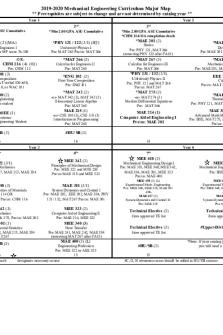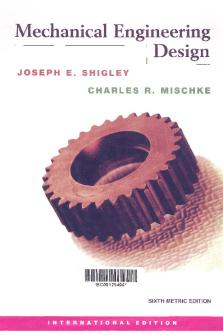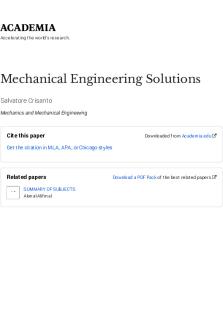Mechanical engineering MEE221 Exercise 02ppppppp PDF

| Title | Mechanical engineering MEE221 Exercise 02ppppppp |
|---|---|
| Author | Muhammad Iqbal Ramadhani |
| Course | Maintenance&Management of Infrastructure |
| Institution | Kyoto University |
| Pages | 3 |
| File Size | 185 KB |
| File Type | |
| Total Downloads | 29 |
| Total Views | 135 |
Summary
Mina san Arigatou gozhaimashita mitete kurete. Mata ashita desu ne thankyou...
Description
MEE221 Engineering Mechanics II
Exercise 2
Exercise 2
1.
(Prob. 12-183) The motor draws in the cable at C with a constant velocity of vc =4m/s. The motor draws in the cable at D with a constant acceleration of aD=8m/s 2. If vD=0 when t=0, determine a. The time needed for block A to rise 3m, and b. The relative velocity of block A with respect to block B when this occurs
2.
(Prob. 12/190) The girl at C stand near the edge of the pier and pulls in the rope horizontally at a constant speed of 1.8 m/s. Determine how fast the boat approaches the pier at the instant the rope length AB is 15 m.
3.
(Prob. 13/12) A car of mass m is traveling at a slow velocity v0. If it is subjected to the drag resistance of the wind, which is proportional to its velocity, i.e., FD=kv, determine the distance and the time the car will travel before its velocity becomes 0.5v 0. Assume no other frictional forces act on the car.
4.
(Prob. 13/26) At the instant shown the 500-N (approx. 50 kg) block A is moving down the plane at 2m/s while being attached to the 250-N (approx. 25 kg) block B. If the coefficient of kinetic friction is k 0.2 , determine the acceleration of A and the distance A slides before it stops. Neglect the mass of the pulleys and cables.
MEE221 Engineering Mechanics II
5.
Exercise 2
(Prob. 13/44) Each of the three plates has a mass of 10 kg. If the coefficients of static and kinetic friction at each surface of contact are s 0.3and
k 0.2 , respectively, determine the acceleration of each plate when the three horizontal forces are applied.
6.
(Prob. 13/48) Block B has a mass m and is hoisted using the cord and pulley system shown. Determine the magnitude of force F as a function of the block’s vertical position y so that when F is applied the block rises with a constant acceleration aB . Neglect the mass of the cord and pulleys.
7.
(Prob. 13/64) The airplane, traveling at a constant speed of 50m/s, is executing a horizontal turn. If the plane is banked at 15 , when the pilot experiences only a normal force on the seat of the plane, determine the radius of curvature of the turn. Also, what is the normal force of the seat on the pilot if he has a mass of 70 kg.
8.
(Prob. 13/70) A collar having a mass of 0.75 kg and negligible size slides over the surface of a horizontal circular rod for which the coefficient of kinetic friction is k 0.3 . If the collar is given a speed of 4m/s and the released at 0 , determine how far, s, it slides on the rod before coming to rest.
MEE221 Engineering Mechanics II
Exercise 2
9.
(Prob. 13/97) The smooth particle has a mass of 80g. It is attached to and elastic cord extending from O to P and due to the slotted arm guide moves along the horizontal circular path r 0.8 sin m. If the cord has a stiffness k=30N/m and an unstretched length of 0.25m, determine the force of the guide on the particle when 60 . The guide has a constant angular velocity 5 rad/s.
10.
(Prob. 13/103) The collar has a mass of 2kg and travels along the smooth horizontal rod defined by the equiangular spiral r e m, where is in radians. Determine the tangential force F and the normal force N acting on the collar when 90 , if the force F maintains a constant angular motion 2 rad/s.
...
Similar Free PDFs

Mechanical-engineering
- 1 Pages

Mechanical engineering
- 1 Pages

2019-2020 Mechanical Engineering
- 2 Pages

Mechanical Engineering Circuits
- 10 Pages

MECHANICAL ENGINEERING REVIEW MANUAL
- 509 Pages

Mechanical engineering lab report
- 18 Pages

Mechanical Engineering Lecture Notes
- 13 Pages

MECHANICAL ENGINEERING REVIEW MANUAL
- 509 Pages

Mechanical Engineering Elements
- 29 Pages

Mechanical engineering design
- 6 Pages

Mechanical Engineering Solutions
- 21 Pages

Mechanical Engineering Level M
- 16 Pages
Popular Institutions
- Tinajero National High School - Annex
- Politeknik Caltex Riau
- Yokohama City University
- SGT University
- University of Al-Qadisiyah
- Divine Word College of Vigan
- Techniek College Rotterdam
- Universidade de Santiago
- Universiti Teknologi MARA Cawangan Johor Kampus Pasir Gudang
- Poltekkes Kemenkes Yogyakarta
- Baguio City National High School
- Colegio san marcos
- preparatoria uno
- Centro de Bachillerato Tecnológico Industrial y de Servicios No. 107
- Dalian Maritime University
- Quang Trung Secondary School
- Colegio Tecnológico en Informática
- Corporación Regional de Educación Superior
- Grupo CEDVA
- Dar Al Uloom University
- Centro de Estudios Preuniversitarios de la Universidad Nacional de Ingeniería
- 上智大学
- Aakash International School, Nuna Majara
- San Felipe Neri Catholic School
- Kang Chiao International School - New Taipei City
- Misamis Occidental National High School
- Institución Educativa Escuela Normal Juan Ladrilleros
- Kolehiyo ng Pantukan
- Batanes State College
- Instituto Continental
- Sekolah Menengah Kejuruan Kesehatan Kaltara (Tarakan)
- Colegio de La Inmaculada Concepcion - Cebu



